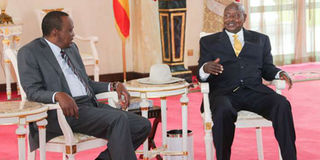Kenya to talk up her security, address costs in Uganda pipeline meet

President Uhuru Kenyatta (left) with Ugandan President Yoweri Museveni at Entebbe State House, Uganda, on August 9, 2015. PHOTO | PSCU.
What you need to know:
- “The Tanzania line now offers a competing route for future crude exports from other Great Lakes countries, especially Eastern DRC and South Sudan,” said George Wachira, director at Petroleum Focus Consultants.
- It is said that the project will offer employment opportunities for 15,000 people. A feasibility study carried out by Toyota Tsusho shows that the route through Kenya will be cheaper even if it will require installation of a heated pipeline.
Kenyan government officials are set to hold a meeting with their Ugandan counterparts to resolve outstanding issues with the hope of influencing the proposed crude oil pipeline route in favour of Kenya.
According to petroleum Principal Secretary Andrew Kamau, the meeting, scheduled to take place within the next 10 days, will address concerns on security for the proposed pipeline, its funding and the lowest cost tariff to be applied, among other issues.
This comes just days after Tanzania’s presidential press unit disclosed that President John Magufuli met Uganda’s Yoweri Museveni and that the two agreed that the pipeline will pass through Tanga.
“Last year, Kenya and Uganda signed a MoU on the pipeline detailing certain conditions. We are working on a meeting within 10 days between the two countries to resolve the issues,” said Mr Kamau on the sidelines of the launch of the energy journalism excellence awards sponsored by the ministry of energy and petroleum and parastatals operating in the sector.
The recent turn of events puts the fate of the crude pipeline in question. Worse, the country stands to lose out on income from transit of the product through the pipeline.
COMPETING ROUTE
“The Tanzania line now offers a competing route for future crude exports from other Great Lakes countries, especially Eastern DRC and South Sudan,” said George Wachira, director at Petroleum Focus Consultants.
According to Mr Kamau, Kenya has the option of constructing its own portion of the pipeline between Lokichar and Lamu in the event that Uganda adopts the route through Tanzania.
In the original plan, a 1,120-kilometre crude oil pipeline is to be set up between Hoima in Uganda through Kenyan oil fields in Lokichar to the proposed port of Lamu at a cost of Sh400 billion.
It is said that the project will create 15,000 jobs. A feasibility study carried out by Toyota Tsusho shows that the route through Kenya would be cheaper even if it would require installing a heated pipeline.
However, French oil explorer Total, which is among the main investors in Uganda’s portion of the pipeline, dismissed the Kenya route, questioning the security situation in the northern part of the country, but Kenya says it has managed to drastically reduce terror incidents.
Kenya is currently pursuing an early oil project that will see about 2,000 barrels of oil produced daily and transported through trucks and rail wagons for export.
The project has been questioned by industry analysts, but the government maintains that it is a temporary undertaking while the proposed pipeline is completed.




